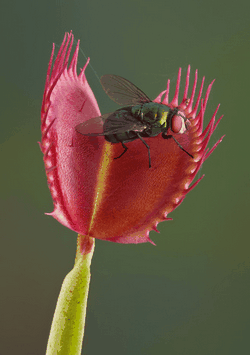While browsing the plants in your local gardening center, building supply store, or even grocery store, most likely you have seen a Venus Fly Trap for sale. Maybe you even bought one, and diligent gardener that you are, you made sure to follow the growing instructions that came with it. Let me guess what happened next. It died after a while, didn’t it? The good news is that it wasn’t your fault.
The people working in these stores typically do not know anything about the plants, and for some reason the plants are often accompanied with the wrong growing instructions. To make it worse, they are kept in conditions in the store that are not conducive to a healthy Fly Trap. The information below will help make your experience growing a Venus Fly Trap a success!
The Venus Fly Trap is native to North America, and is not a tropical plant, thus does not need high humidity. It can be grown easily outdoors in most of the United States year round. In fact, it is native to North Carolina. Constant high humidity weakens a plant, so when you purchase a plant that has been kept in this condition, you are purchasing a weak plant. Another problem with the high humidity environment is that it invites fungal infections. So most likely you have bought a weakened plant that is already sick. This is a recipe for disaster.
Mistake #2: Lighting
The Venus Fly Trap needs full sun. There is no way to accomplish that by growing this plant inside. A lamp or a windowsill is not enough. The Venus Fly Trap must be placed in your yard so that it receives full sunlight all day long, even during the heat of the summer. Do not give it partial shade.
Mistake #3: Bringing you venus fly trap inside during the winter.
Never bring your Venus Fly Trap indoors during the winter. It must have a winter dormancy. The traps will die off, but the plant is getting a much-needed rest during this time. If your plant skips its winter dormancy period, it will be weakened when spring comes again. Leave it outside and let it sleep! You wouldn’t feel very good if someone forced you to stay awake all night and expected you to function normally the next day. It is the same with this plant. Let it sleep during the winter. It will wake up refreshed and ready to grow bigger and better in the spring.
Mistake #4: Water.
The Venus Fly Trap does like very wet soil, but you have to be careful what type of water you use. Tap water is not good. With constant tap water use, minerals will build up that are harmful to the plant. You need to use pure water. Hopefully it is getting enough rain water, but during the times when you must water it, pure water is best, like distilled water.
Mistake #5. Fertilizing.
Never fertilize your Venus Fly Trap! These plants are unique in that they get their nutrition from the bugs they eat. Their roots are used to hold them in place and to give them water. They are not designed to soak up food through their roots like other plants. A fertilizer in the soil will burn your poor, little venus fly trap(s)!
Mistake #5. Soil.
Venus Fly Traps need a nutrient-free, acidic soil that most plants would not be happy in. A good soil mixture is an even mixture of peat moss and perlite. Peat moss holds a lot of moisture and is acidic. The perlite helps with aeration. Without it, the roots could rot. They need lots of water, but also lots of air flow. When looking for peat moss, make sure it doesn’t contain fertilizer. Look for sphagnum peat moss, Canadian peat moss, or simply peat moss. These are just different names for the same thing. Do not use green decorative moss.
The plants that you pick up from your local gardening center that are grown in a terrarium and given tap water and insufficient lighting are doomed from the start. Even the veteran Venus Fly Trap growers usually can’t save the plants grown this way. They are unhealthy and weak, and if you take them and place them in your yard in full sun as mentioned above, the shock of the sudden change will kill them. The best place to get your Venus Fly Trap would be directly from the grower. If you must purchase one from an uninformed garden center or chain store, follow these steps:
1. You must harden it off first. Remove the lid a little at a time to let the plant get used to a lower humidity.
2. Change the soil to remove hard water deposits. Wash it off bare root and replant it with peat moss and perlite. Make sure to use pure distilled water or rain water when watering your Fly Trap.
3. Once you have gotten it used to the regular humidity inside your house, you can slowly introduce it to the outside. Start by giving it two hours of full morning sunlight, then move it back into the shade. The next day, put it in the sun at the same time and leave it three hours, and so on until you can leave it in the sun all day long.
4. Don’t get discouraged! Chances are that if your plant was unhealthy to start with, nothing you can do will save it. Purchase a healthy plant and follow these instructions and you can’t go wrong!
Everyone likes to grow something … or they should. If you have some space restrictions (or not) go to Urban Garden Handbook. You’ll be glad you did.


